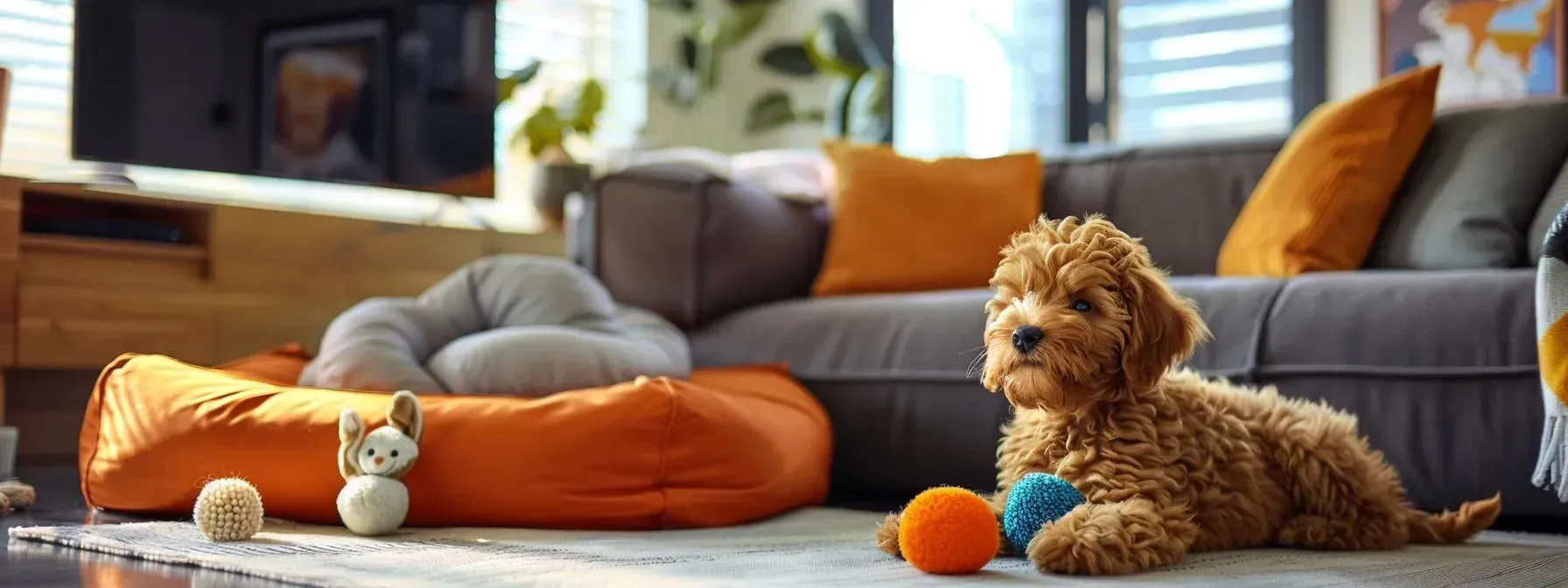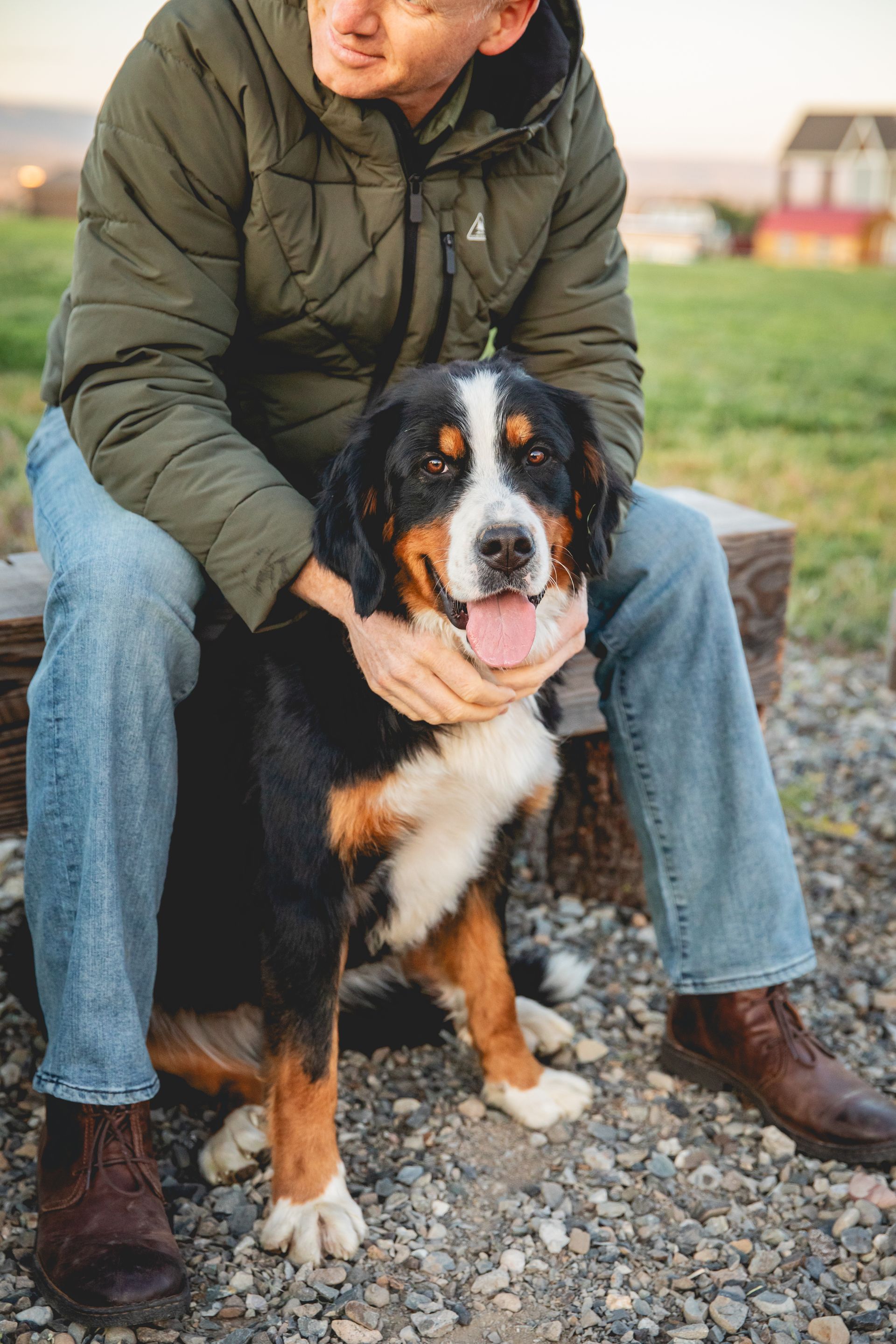Blog

Discover Why This Lovable Crossbreed Could Be the Perfect Addition to Your Home Thinking of adding a dog to your family? If you're searching for a loyal, gentle, and trainable companion that thrives in family life, the Bernedoodle may just be your dream dog. This Bernese Mountain Dog and Poodle mix brings together smarts, affection, and a temperament that's practically designed for home life. Let’s break down what makes the Bernedoodle an ideal choice for families—and what you need to know before bringing one home. Bernedoodles and Family Life: A Natural Match Gentle, Loving, and Kid-Friendly Bernedoodles are naturals with children. Their patience, playfulness, and loving nature make them one of the safest breeds for homes with kids. They don’t just tolerate children—they bond with them. Whether it’s curling up for movie night or chasing bubbles in the backyard, Bernedoodles are all in. Adaptable to Any Living Situation Big home? Small apartment? Busy household? Bernedoodles adjust beautifully. Thanks to their balanced energy levels and social nature, they’re just as comfortable in a suburban home as they are in a city condo—as long as they’re getting love, attention, and daily exercise. Gets Along With Other Pets Worried about how they’ll interact with your cat, other dog, or even a rabbit? Bernedoodles tend to be calm and friendly with other animals, especially when introduced properly. Their non-aggressive demeanor makes them ideal for multi-pet households. Grooming: What You Need to Know Expect Regular Grooming—But Nothing Overwhelming That fluffy coat isn’t just for show. Depending on your Bernedoodle’s genes, it could be curly, wavy, or somewhere in between. Regardless, regular brushing (at least weekly) and professional grooming every 6–8 weeks are a must. Tools You’ll Want On Hand A slicker brush, a wide-tooth comb, and a gentle shampoo are your best friends. These basic tools keep their coat clean, detangled, and mat-free—and they’re a great way to bond with your dog. Save Time With a Home Routine Don’t wait for tangles to turn into mats. Just 10–15 minutes of brushing a few times a week can save you a pricey grooming bill—and make your Bernedoodle look fantastic. Training: Build the Dog You Want Bernedoodles Love to Learn Smart, eager to please, and sensitive to your tone—Bernedoodles thrive with positive reinforcement. Use treats, praise, and consistency, and you’ll see fast results. Start Early and Socialize Often Expose your pup to new places, faces, and sounds while they’re young. Early socialization helps curb anxiety and ensures your dog grows into a confident, friendly companion. Make Training Fit Your Life Don’t have an hour to train every day? No problem. Short, consistent sessions (10 minutes before dinner or after school) are far more effective. Make it fun. Make it frequent. The results will show. Exercise: Energy That Works With Your Family Daily Play Is a Must A Bernedoodle that doesn’t get enough exercise will find ways to burn that energy—and you might not like how. Aim for 1–2 hours per day of walking, running, or play. Mix it up with games like tug-of-war, fetch, or agility drills. Brain Games Matter Too Keep your pup sharp with puzzle toys, training games, and scent work. Mental exercise is just as important as physical activity for this intelligent breed. Know When It’s Too Much Bernedoodles also need downtime. Don’t overschedule. Let them rest and recharge so they’re ready for more family fun tomorrow. What It Really Costs to Own a Bernedoodle Startup Costs Expect to pay anywhere from $500 to $4,000 depending on breeder quality, coat type, and location. Don’t skimp—choose a reputable breeder with health testing or adopt from a verified rescue. Monthly Expenses Food, grooming supplies, toys, and basic vet care will run $100–$200/month. Add pet insurance if you want extra peace of mind. Hidden Costs Unexpected vet bills, dog training, or travel accommodations can add up. Plan for the unexpected and avoid surprises. Community: You’re Not Alone Connect With Other Owners Join Facebook groups, online forums, or local meetups. Other owners offer invaluable tips, and your Bernedoodle will love the social time. Learn From the Best Attend breed-specific events, dog training workshops, or pet expos. These give you face time with pros and help you raise a happier, healthier dog. Build Lifelong Friendships You’re not just getting a dog—you’re joining a tribe. The Bernedoodle community is full of passionate, dog-loving families just like yours. Final Thoughts: Is a Bernedoodle Right for You? If you want a loving, loyal, smart, and adaptable dog that fits seamlessly into family life, the Bernedoodle delivers. With the right grooming routine, consistent training, daily activity, and thoughtful budgeting, this breed gives back tenfold in affection and joy. Ready to meet your new best friend? Start researching trusted breeders or adoption centers near you. And get ready for years of cuddles, adventures, and unforgettable memories. FAQs Q: Are Bernedoodles good with kids? A: Yes—extremely. Their calm and gentle nature makes them perfect playmates. Q: How often should I groom a Bernedoodle? A: Brush at least weekly and schedule professional grooming every 6–8 weeks. Q: What’s their energy level like? A: Moderate to high. They love activity but settle down nicely indoors. Q: Are they easy to train? A: Yes. Bernedoodles are intelligent and respond well to positive reinforcement. Q: What should I budget for monthly care? A: Plan on $100–$200 for food, grooming, toys, and vet care.

Starting the journey with your Bernedoodle puppy can feel overwhelming—but it doesn’t have to be. With the right foundation, your puppy can grow into a calm, confident, and obedient companion. This guide walks you through everything you need to know to train your Bernedoodle effectively—from building trust to teaching commands—so your puppy thrives in your family environment. You’ll discover how to: Build a strong emotional bond using play, praise, and positive reinforcement. Set up a distraction-free training space that encourages learning. Implement daily routines that create clarity, consistency, and results. Socialize your puppy to reduce future behavioral issues. Track progress and adjust as your Bernedoodle grows. Establish a Strong Bond With Your Bernedoodle Puppy A strong bond is the foundation of all effective training. Before you teach commands, your puppy must see you as a source of safety, love, and leadership. Use Positive Reinforcement for Fast Learning Reward good behavior immediately. When your puppy sits, comes, or stays on command, follow with a treat, enthusiastic praise, or a belly rub. This links the action to a positive result. Example: Your Bernedoodle sits when you say “sit.” Instantly give a small treat and say, “Good boy!” in a happy tone. That’s how habits form. Build Trust Through Daily Quality Time Training doesn’t only happen during drills. It happens during walks, cuddle time, and even grooming. These bonding moments help your puppy feel secure and reinforce your role as a leader. Make Playtime Part of the Training Process Games like fetch, tug-of-war, and hide-and-seek build rapport and can sneak in training. Use them to practice commands like “drop it,” “stay,” and “come” in a fun, low-pressure way. Implement Consistent Training Techniques for Results Consistency is king. If your commands and schedule vary, your puppy will feel confused and anxious. Keep things simple and repeatable. Stick to a Daily Training Routine Aim for 2–3 short sessions (10–15 minutes each) per day. Morning, mid-day, and evening sessions keep your puppy engaged without overwhelming them. Use Clear, Simple Commands Choose one word per command: “Sit,” “Stay,” “Come.” Say it the same way every time. Don’t say, “Come on, let’s go!” one day and “Come here, puppy!” the next. Consistency leads to clarity. Reward Instantly for Maximum Impact The reward must come within 2–3 seconds of the behavior. That’s how dogs connect the dots. A delay confuses the message. Create a Safe, Distraction-Free Learning Environment Puppies are easily distracted. You need a training space that sets your Bernedoodle up for success. Designate a Quiet Training Zone Pick a calm area with minimal noise and foot traffic. Carpet or yoga mats help avoid slipping. This space becomes the “classroom” where your puppy knows it’s time to focus. Eliminate Noise and Movement Turn off TVs, silence phones, and keep other pets out. Distractions reduce your puppy’s ability to process and retain new commands. Add Familiar Comfort Items Blankets, soft toys, or even a T-shirt with your scent can lower anxiety. These familiar items create a calm learning atmosphere, especially in the early weeks. Socialize Your Bernedoodle for Balanced Behavior Socialization is non-negotiable. Early exposure to people, animals, and places reduces future fear-based behaviors. Introduce New People and Environments Gradually Walk your puppy around the neighborhood, visit friends’ homes, or stroll through pet-friendly stores. Let your puppy take in the world at a comfortable pace. Schedule Controlled Dog Interactions Enroll in puppy playgroups or classes. These interactions help your Bernedoodle learn bite inhibition, respect boundaries, and develop healthy play habits. Desensitize to Common Sounds and Sights Vacuum cleaners, doorbells, traffic—these should all be introduced gently and progressively. Normalize them now to avoid anxiety later. Teach Basic Commands to Build Manners and Safety Commands like “Sit,” “Stay,” and “Come” aren’t just cute—they’re essential for safety and harmony. Begin With Sit, Stay, and Come Teach these in a quiet space using food rewards. “Sit” builds calm. “Stay” builds impulse control. “Come” prevents danger if your dog bolts or wanders. Leash Train Early for Walk Control Practice short indoor walks with rewards for staying at your side. Gradually introduce outdoor walks. Bernedoodles love to explore, but leash manners protect them (and your shoulder!). Use Games to Reinforce Training Naturally Make learning a game. Use hide-and-seek for recall training. Tug-of-war with a “drop it” command builds impulse control. Fun increases engagement and retention. Track Progress and Adjust as Needed No two Bernedoodles are exactly alike. Some will catch on in days; others need weeks. Stay flexible. Keep a Simple Training Log Track which commands you’re working on, what’s going well, and where your puppy struggles. Snap photos or take short videos—progress is easier to spot when documented. Adjust Based on Results Is your puppy ignoring “stay”? Try shorter durations or a different reward. Don’t force what isn’t working—adapt. The best trainers are observers first, instructors second. Celebrate Every Win Small wins build momentum. Celebrate a 3-second “stay” with a treat or short play session. Progress happens in inches, not miles. Final Thoughts Training your Bernedoodle puppy doesn’t have to be stressful—it can be one of the most rewarding parts of pet ownership. By building a bond based on trust, staying consistent, and adjusting as you go, you’ll raise a dog who’s not just obedient, but joyful to train. Stick with the plan, trust the process, and enjoy the journey. Your puppy is learning how to thrive—and you’re learning how to lead. Frequently Asked Questions Q: How does positive reinforcement help in training my Bernedoodle? A: It links behavior to reward, helping your puppy repeat good actions with confidence and excitement. Q: What should be included in a daily training schedule? A: Two to three short training sessions, regular walks, downtime, and one-on-one bonding moments. Q: How do I create a distraction-free training area at home? A: Choose a quiet, low-traffic spot with soft flooring. Remove electronics, noise, and other pets. Q: Why is socialization important for a Bernedoodle puppy? A: It helps your puppy feel confident in new environments, reduces reactivity, and fosters polite behavior. Q: When should I start leash training my Bernedoodle? A: As early as 8–10 weeks using a gentle, reward-based approach. The earlier you start, the better the results.

This guide is designed to help you understand every aspect of Bernedoodle puppies—the cherished mix between the intelligent Poodle and the gentle Bernese Mountain Dog. In today’s market where pet stores, breeders, and even online meeting platforms often use terms like “poodle,” “doodle,” or “dog breed” for marketing, it can sometimes be overwhelming to decide which breed is right for your lifestyle. Our article provides a look at the origins, characteristics, temperament, health issues, training, and care of the Bernedoodle. By integrating insights from peer-reviewed research along with the expertise of a seasoned dog breeder, we ensure that you'll gain accurate information on topics ranging from vaccination and nutrition to body size, grooming, and even the financial considerations of pet pricing. You will learn how to prepare your home for a new puppy, understand the inherited traits from both parent breeds, and discover training and enrichment activities that supp ort mental clarity and social behavior in your Bernedoodle. As you read on, you will find detailed lists, tables comparing key attributes, and informative studies that back up the insights provided. Let’s embark on this journey to understanding the Bernedoodle and make a well-informed decision in your next puppy purchase.

